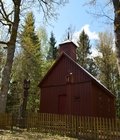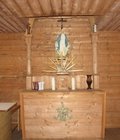The full name of the chapel is Sorai Holy Antanas Paduvietis chapel, but it is usually called the Sorai Chapel. The chapel's name sounds strangely and mysteriously. In ancient times, Samogitians did not have the words “anger, argue”, but they said: “sora” or “soros”. It is symbolic that the Sorai Chapel was built on the borders of three parishes: Alsėdžiai, Gegrėnai and Samogitian Kalvarija. It seems to look like the people of these three parishes can meet here to become cohabiting and stand apart without the anger in their hearts.
The Sorai chapel was built in 1917 and supervised by the owner of the nearby Daugėliai manor, Klemensas Daugėla. According to the legend, the church once stood in this place, which was burned by Swedes in the seventeenth century. In 1944, when the Samogitian Kalvarija was occupied by the Soviet Army, monks marijons moved to Daugėlai Manor. In the Sorai Chapel they sacrificed St. Mass, married couples, baptized newborns.
At the start of the occupation, the owners of the estate were deported. Sorai Chapel was under care for some time and the handler, who tried to protect the chapel from time and fire, had completely clogged it with metal cans. They were later removed.
People tell that bell tower had a very rattling bell, but after all conquests it was mysteriously lost, just like the inside sculpture of Mary. Locals also say that behind the Sorai chapel there is the site of former burial, where many infants and young children are buried. Another story tells us that during post-war years there was a partisan bunker under the chapel. There could have been the entrance to the forest hidden, which could have been used by guerrillas to enter the basement under the chapel.

+2




Reviews